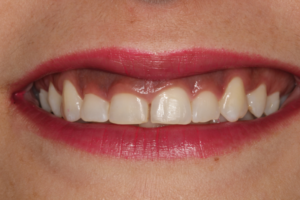Artigo apresenta relato de caso clínico com um follow-up de dois anos e seis meses sobre um tratamento regenerativo de defeito periodontal infraósseo localizado.
AUTORES
Fernando Antônio Mauad de Abreu
Doutor em Biologia Celular – UFMG; Professor adjunto de Odontologia – PUC Minas.
Orcid: 0000-0001-7399-7153.
Gabriel Gonçalves Amaral
Especialista em Prótese Odontológica e mestrando em Implantodontia – PUC Minas.
Orcid: 0000-0001-5343-9437.
Anna Carolinna Gama de Assis
Graduanda em Odontologia – PUC Minas; Membro da Liga Acadêmica de Periodontia e Implantodontia.
Orcid: 0000-0002-4458-8673.
Ana Luiza Rodrigues de Azevedo
Graduanda em Odontologia – PUC Minas; Membro da Liga Acadêmica de Periodontia e Implantodontia.
Orcid: 0000-0001-9720-1981.
Ananda Vitória Nunes Barbosa
Graduanda em Odontologia – PUC Minas; Membro da Liga Acadêmica de Periodontia e Implantodontia.
Orcid: 0000-0002-4246-0748.
Lorena Miranda Monteiro
Graduanda em Odontologia – PUC Minas; Membro da Liga Acadêmica de Periodontia e Implantodontia.
Orcid: 0000-0002-8000-273X.
RESUMO
O presente artigo apresentou um relato de caso clínico com um follow-up de dois anos e seis meses sobre um tratamento regenerativo de defeito periodontal infraósseo localizado, com recuperação e manutenção considerável da inserção clínica do periodonto de sustentação. Paciente com 29 anos de idade, no ano de 2018, foi diagnosticado com periodontite (estágio III, grau C), sendo tratado com terapia regenerativa periodontal utilizando biomaterial xenógeno associado às proteínas derivadas da matriz do esmalte, após concluída a fase não cirúrgica do plano de tratamento periodontal. Foi monitorado seu controle de biofilme e reavaliado em sua inserção clínica aos 30 e 180 dias, por meio de tomografia computadorizada. Aos 30 meses, foi constatada a manutenção do ganho de inserção clínica pelos parâmetros clínicos periodontais e por tomografia computadorizada. Nesse contexto, concluiu-se que a terapia periodontal regenerativa relatada associada a um bom planejamento e execução de etapas em um tratamento periodontal, além de um devido controle de biofilme, concretizaram o ganho de inserção clínica observado.
Palavras-chave – Biomaterial; Regeneração tecidual guiada periodontal; Sobrevivência de Enxerto; Xenoenxertos.
ABSTRACT
This article presents a clinical case report with a 2-year and 6-month follow-up on a regenerative treatment of a localized infra-bone periodontal defect, considerable recovery and maintenance of the clinical insertion of the sustaining periodontium. A 29-year-old patient, in 2018, was diagnosed with stage III grade C periodontitis. After completing the non-surgical phase of a periodontal treatment plan, periodontal regenerative therapy was performed. Xenogenous biomaterial associated with proteins derived from the enamel matrix was used. The biofilm control was monitored and reassessed at its clinical insertion at 30 and 180 days, using computed tomography. At 30 months, it was observed that this gain of clinical insertion was maintained, due to periodontal clinical parameters and computed tomography. In this context, it is concluded that the reported regenerative periodontal therapy, associated with good planning of stages in periodontal treatment and the proper biofilm control, achieved the observed clinical insertion gain.
Key words – Biomaterial; Guided tissue regeneration periodontal; Graft survival; Heterografts.
Referências
- Sallum EA, Ribeiro FV, Ruiz KS, Sallum AW. Experimental and clinical studies on regenerative periodontal therapy. Periodontol 2000 2019;79(1):22-55.
- Nyman S, Gottlow J, Karring T, Lindhe J. The regenerative potential of the periodontal ligament. An experimental study in the monkey. J Clin Periodontol 1982;9(3):257‐65.
- Goldman H, Cohen W. The infrabony pocket: classification and treatment. J Periodontol 1958;29:272-91.
- Steffensen B, Webert HP. Relationship between the radiographic periodontal defect angle and healing after treatment. J Periodontol 1989;60(5):248-54.
- Papapanou PN, Tonetti MS. Diagnosis and epidemiology of periodontal osseous lesions. Periodontol 2000 2000;22:8-21.
- Sculean A, Nikolidakis D, Nikou G, Ivanovic A, Chapple IL, Stavropoulos A. Biomaterials for promoting periodontal regeneration in human intrabony defects: a systematic review. Periodontol 2000 2015;68(1):182-216.
- Cortellini P, Tonetti MS. Clinical concepts for regenerative therapy in intrabony defects. Periodontol 2000 2015;68(1):282-307.
- Greene JC, Vermillion JR. The simplified oral hygiene index. J Am Dent Assoc 1964;68:7-13.
- Feres M, Figueiredo LC, Soares GM, Faveri M. Systemic antibiotics in the treatment of periodontitis. Periodontol 2000 2015;67(1):131-86.
- Queiroz AC, Nóbrega PB, Oliveira FS, Novaes Jr. AB, Taba Jr. M, Palioto DB et al. Treatment of intrabony defects with anorganic bone matrix/p-15 or guided tissue regeneration in patients with aggressive periodontitis. Braz Dent J 2013;24(3):204-12.
- Stavropoulos A, Karring T. Guided tissue regeneration combined with a deproteinized bovine bone mineral (Bio-Oss) in the treatment of intrabony periodontal defects: 6-year results from a randomized-controlled clinical trial. J Clin Periodontol 2010;37(2):200-10.
- Miron RJ, Dard M, Weinreb M. Enamel matrix derivative, inflammation and soft tissue wound healing. J Periodontal Res 2015;50(5):555-69.
- Esposito M, Grusovin MG, Papanikolaou N, Coulthard P, Worthington HV. Enamel matrix derivative (Emdogain) for periodontal tissue regeneration in intrabony defects. A Cochrane systematic review. Eur J Oral Implantol 2009;2(4):247-66.
- Matarasso M, Iorio-Siciliano V, Blasi A, Ramaglia L, Salvi GE, Sculean A. Enamel matrix derivative and bone grafts for periodontal regeneration of intrabony defects. A systematic review and meta-analysis. Clin Oral Investig 2015;19(7):1581-93.
- Reynolds MA, Kao RT, Camargo PM, Caton JG, Clem DS, Fiorellini JP et al. Periodontal regeneration – intrabony defects: a consensus report from the AAP Regeneration Workshop. J Periodontol 2015;86(2 suppl.):105-7.





